Well cementing: objectives and methods
In the article we will try to figure out why and with what methods cementing is performed. We will immediately agree: we will closely consider a relatively narrow area - drilling for water.
The oil and gas industry has its own specifics, which we will only touch on in part.
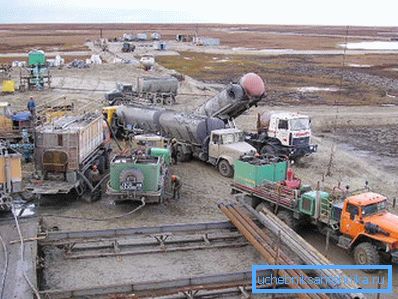
Why is this done?
The main reasons for cementing a well are:
- Cementing improves overall structural strength.. The casing holds the borehole walls; however, when the ground moves, the resulting forces can be prohibitively large for the strength of its walls. If the casing is reinforced by cementing - the chances of destruction of the wellbore are markedly reduced.
- Cementation creates a protective layer, prevents erosion of the pipe by soil water and corrosion of steel pipe.
- Finally, the last and most important thing. At different levels of soil there are different aquifers. What does a well do? Combines them.
As a result, water at different levels is mixed. Drains from cesspools and septic tanks along with rainwater fall into the artesian water from the deep layers; Yes, and simply combining the aquifer with sandy and sandy sandy soil, the compression channel can lead to the fact that the water begins to go into the sand. (See also the article How to equip a well qualitatively.)
Well cementing is designed to hinder this process. It forms a deaf cork around the casing, a seal that prevents water from migrating between the levels.
Please note: well cementing and cementing are not synonymous, as it is easy to solve by the similar sound of words.
Cementing, or tamponage - is the elimination of a well, its filling with a solution (usually under pressure).
The goal is again to separate the aquifers of different ground levels.
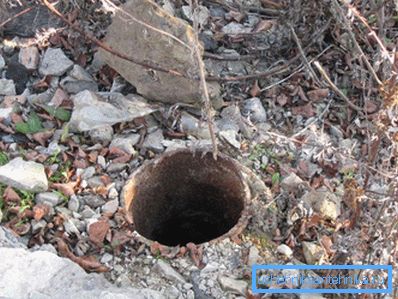
How it's done?
Materials
In general, the solutions used in well cementing are divided according to several criteria.
- Well temperature. The deeper the well, the higher the temperature in it and the faster the solution dries. Cements are divided for cold (up to 40 C) wells; hot with temperatures up to 75 ° C and deep ones with temperatures up to 120 ° C. The first ones harden under the same conditions much faster. Of course, when drilling into water, the last two options are irrelevant. The wells simply do not reach the depths with such temperatures.
- Supplements. Used cement with quartz sand, not giving shrinkage; fiber cement with the addition of cellulose, which almost does not penetrate into loose rock; expanding cement, which compacts the soil around the wellbore when solidified. Finally, pozzolanic cements that pass water and at the same time are not afraid of aggressive impurities.
- Water / cement ratio. The more water - the more fluid the solution, but the longer it sets. In addition, solutions with a lower water content after solidification are more durable.

Methods
The following methods of well cementing are used during drilling:
- Solid cementing. It is also a single-stage well cementing. The essence of the method is as follows: a cementing solution is poured into the casing; it is covered with a tight stopper; after that, the washing solution is injected into the column. Cork gradually displaces cement into the space around the column.

- Two stage cementing. The well is cemented in two steps: the lower and then its upper part. The method is applied if it is problematic to immediately prepare the right amount of solution, or if the state of the soil layers and the temperature in the upper and lower parts of the well differ greatly.
Please note: two-stage cementing can be performed both with a gap in time, after the first portion of the solution has hardened, or immediately.
For cement layers, a separator ring is needed.
- Lip cementing. This well cementing technology is used if only the upper part of the well is to be isolated from the soil. At the required level between the casing and the ground is put a ring cuff. The solution is injected above it through the perforations in the barrel.
- Reverse cementing. Cement is injected not into the column, but into the gap between it and the ground. When this cleaning or drilling fluid is displaced through the cavity of the column.
Equipment
The equipment for cementing wells is rather cumbersome and requires the use of a truck as a mobile carrier. Typically, cementing systems are mounted on Ural, KamAZ or KrAZ vehicles.
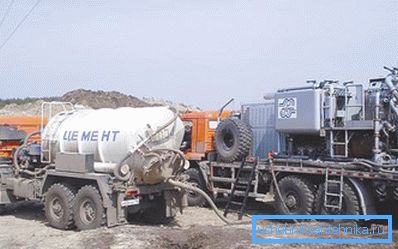
A car engine is used as an energy source for operation of loading and metering conveyors, mixing and control systems. Pressure pumps may be located on the same chassis. Their maximum injection pressure of the solution can reach an impressive 35 MPa. (See also the article Features of the replacement of the pump in the well)
What happens to the cement mortar in this installation?
- Cement is metered into the mixer. There also comes the right amount of water.
- Cementing solution is mixed to complete homogeneity.
- Then the injection pumps feed the solution into the casing or the surrounding space using a cementing head.
Who specializes in well cementing equipment in our country? First of all, it is a well cementing center located in the village of Novy Urengoy, which is part of Gazprom drilling. Its branches and workshops are located in Astrakhan, Orenburg, Krasnodar and Ukhta.
Quality control
Quality assessment of cementing wells is currently carried out by the following methods:
- Thermal. In the process of cement hardening, a certain amount of heat is released. To find out how high the cement rose outside the casing, it is sufficient to measure the temperature of its walls at several points.
- Acoustic. Sections of the casing, surrounded by cement and free from it, differently fluctuate with the passage of an acoustic wave through it. Where vibrations subside quickly, cementing is reliable. Where the wave propagates without attenuation, there is no cement behind the column.
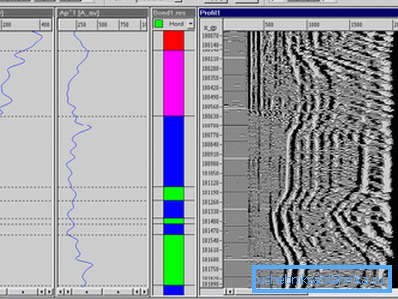
- Radiological method (aka gamma-gamma logging). The source of gamma radiation is lowered into the well, and the radiation from it is recorded by radially spaced sensors on the surface.
If, as the radiation source rises and lowers, the intensity plots are uniform and the same on all sensors, the cementing is satisfactory. If the graphs are uneven and different - cementing is uneven, has defects, or is not fully implemented.
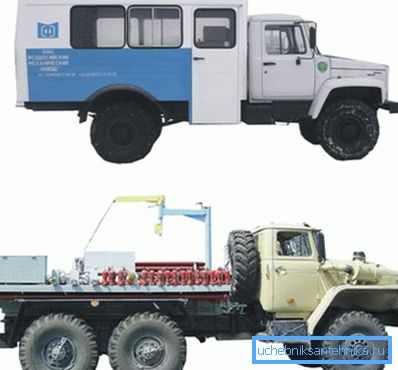
Note: these methods are appropriate in the case of cementing the walls of the casing. When a cement bridge is installed in a well (a kind of second bottom of the well, which cuts its lower part from the top and separates layers of soil at different levels), it is very difficult to check its tightness and strength by non-destructive methods. (See also the article Which Pump is Better for a Well to Choose.)
Conclusion
Unfortunately, in the framework of this article we can only acquaint the reader with the basics of terminology and technology. Well cementing is a rather complicated science, which, alas, cannot be told in two words. However, let's hope you got a general idea of the issue.